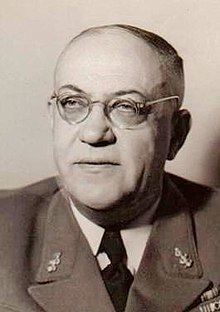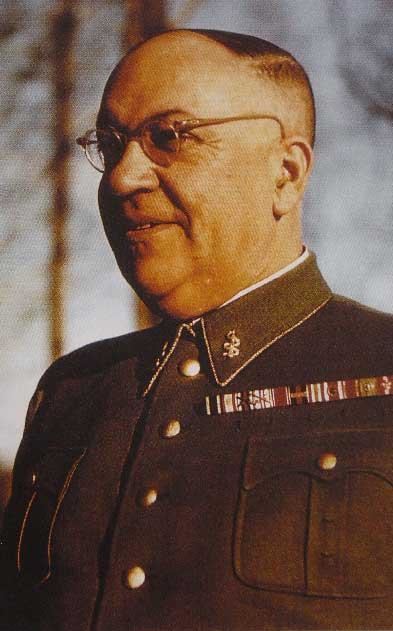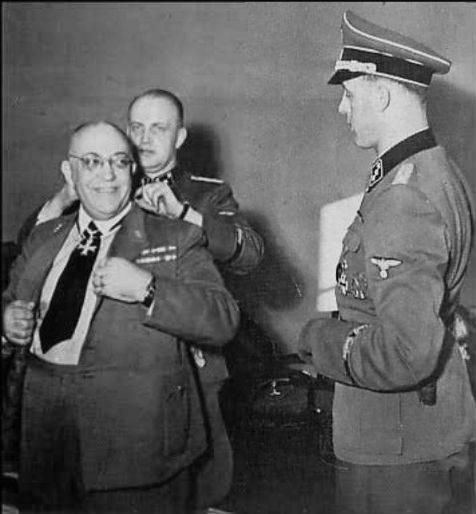Occupation Medical Doctor Name Theodor Morell | Role Physician | |
 | ||
Full Name Theodor Gilbert Morell Born 22 July 1886 ( 1886-07-22 ) Trais-Munzenberg, Germany Spouse(s) Hannelore Moller (since 1920) Books The SECRET DIARIES OF HITLERS DOCTOR | ||
Theodor Morell Documentary - Biography of the life of Hitler's Doctor Theodor Morell
Theodor Gilbert Morell (22 July 1886 – 26 May 1948) was a German doctor known for acting as Adolf Hitler's personal physician. Morell was well known in Germany for his unconventional treatments. He assisted Hitler daily in virtually everything he did for several years and was beside Hitler until the last stages of the Battle of Berlin.
Contents
- Theodor Morell Documentary Biography of the life of Hitlers Doctor Theodor Morell
- The Amphetamines That Kept German Troops Going
- Early years
- Hitlers physician
- Substances administered to Hitler
- World War II
- Final years and death
- References

The Amphetamines That Kept German Troops Going
Early years

Morell was the second son of a primary school teacher, born and raised in the small village of Trais-Münzenberg in Upper Hesse. His family was reportedly partly Jewish. He studied medicine in Grenoble and Paris, then trained in obstetrics and gynecology in Munich in 1910. On 23 May 1913, he obtained a doctoral degree and was fully licensed as a medical doctor. He served as a ship's doctor until 1914, when he volunteered for service at the Front during the First World War. Morell served as an army battalion medical officer until 1917. By 1918, he was in Berlin with his own medical practice, and in 1920 he married Hannelore Moller, a wealthy actress. He furnished his office with the latest medical technology through his wife's fortune. He targeted his unconventional treatments at an upscale market and turned down invitations to be personal physician to both the Shah of Persia and the King of Romania.
Hitler's physician

Morell joined the Nazi Party when Hitler came to power in 1933. In 1935, Hitler's personal photographer, Heinrich Hoffmann, was successfully treated by Morell. Hoffmann told Hitler that Morell had saved his life. Hitler met Morell in 1936, and Morell began treating Hitler with various commercial preparations, including a combination of vitamins and hydrolyzed E. coli bacteria called Mutaflor, which successfully treated Hitler's severe stomach cramps. Through Morell's prescriptions, a leg rash which Hitler had developed also disappeared. Hitler was convinced of Morell's medical genius and Morell became part of his social inner circle.

Some historians have attempted to explain this by citing Morell's reputation in Germany for success in treating syphilis, along with Hitler's own (speculated) fears of the disease, which he associated closely with Jews. Others have commented on the possibility that Hitler had visible symptoms of Parkinson's disease, especially towards the end of the war.

Hitler recommended Morell to others of the Nazi leadership, but most of them, including Hermann Göring and Heinrich Himmler, dismissed Morell as a quack. As Albert Speer related in his autobiography:
In 1936, when my circulation and stomach rebelled...I called at Morell's private office. After a superficial examination, Morell prescribed for me his intestinal bacteria, dextrose, vitamins and hormone tablets. For safety's sake I afterward had a thorough examination by Professor von Bergmann, the specialist in internal medicine at Berlin University. I was not suffering from any organic trouble, he concluded, but only from nervous symptoms caused by overwork.
I slowed down my pace as best I could and the symptoms abated. To avoid offending Hitler I pretended that I was carefully following Morell's instructions, and since my health improved, I became for a time Morell's showpiece. – Albert Speer, Inside the Third Reich(1969)
When Hitler was troubled with grogginess in the morning, Morell would inject him with a solution of water mixed with a substance from several small, gold-foiled packets, which he called "Vitamultin". Hitler would arise, refreshed and invigorated. Hitler gave a packet to Himmler, who immediately became suspicious and instead secretly ordered one of his SS physicians, Ernst-Günther Schenck, to have it tested in a laboratory. It was found to contain methamphetamine. On at least one occasion Hitler ordered his private train stopped so that Morell could inject him without worrying about the train jostling.
Speer characterised Morell as an opportunist, who once he achieved status as Hitler's physician, became extremely careless and lazy in his work. He was more concerned about money and status rather than providing medical assistance. By 1944, Morell developed a hostile rivalry with Dr. Karl Brandt, who had been attending Hitler since 1934. Though criticized by Brandt and other physicians, Morell was always "restored to favor".
Göring called Morell an unflattering nickname that stuck: Der Reichsspritzenmeister, ("Injection Master of the German Reich," Reichmaster of Injections, "The Reich's Injections Impresario" (Junge, Until the Final Hour), and "The Master of the Imperial Needle".) The underlying meaning is the same: it implied that Morell resorted to using injections when faced with medical problems and overused these drug injections.
Substances administered to Hitler
Morell kept a medical diary of the drugs, tonics, vitamins and other substances he administered to Hitler, usually by injection (up to 20 times per day) or in pill form. Most were commercial preparations, some were Morell's own mixes. Since some of these compounds are considered toxic, historians have speculated that Morell inadvertently contributed to Hitler's deteriorating health. The fragmentary list (below) of some 74 substances (in 28 different mixtures) administered to Hitler include psychoactive drugs such as heroin as well as commercial poisons. Among the compounds, in alphabetical order, were:
- Atropa belladonna (2–4 pills with every meal in Koster's Antigaspills, compound containing strychnine, subject of investigation)
- atropine (extract of seminal vesicles)
- Brom-Nervacit (bromide, since August 1941 a spoonful almost every night, to counteract stimulation from methamphetamine and permit sleep)
- caffeine
- chamomile
- cocaine and adrenaline (via eyedrops)
- E. coli
- enzymes
- Eukodal or Eukodol (trade name for oxycodone)
- Eupaverinum (papaverine, antispasmotic)
- Glyconorm (metformin)
- Methamphetamine (as Pervitin and Vitamultin)
- morphine
- Mutaflor (pills prescribed to Hitler for flatulence in 1936, the first unorthodox drug treatment from Morell; bacteria extracted from human faeces, see: E. coli)
- oxedrine tartrate
- potassium bromide
- prophenazone (a derivative of Phenazone)
- proteins and lipids derived from animal tissues and fats
- sodium barbitone
- strychnine
- sulfonamide
- testosterone
- vitamins
An almost complete listing of the drugs used by Morell, wrote historian Hugh Trevor-Roper, was compiled after the war from his own meticulous daily records unlikely to have been exaggerated.
World War II
In 1939, Morell inadvertently became involved with the invasion of Czechoslovakia. The Czechoslovak president, Emil Hacha, became so scared at Hitler's outburst that he fainted. Morell injected stimulants into Hacha to wake him, and although he claimed these were only vitamins, they may have included methamphetamine. Hacha soon gave in to Hitler's demands.
After the 20 July 1944 assassination attempt against Hitler, Morell treated him with topical penicillin, which had only recently been introduced into testing by the U.S. Army. Where he acquired it is unknown, and Morell claimed complete ignorance of penicillin when he was interrogated by American intelligence officers after the war. When members of Hitler's inner circle were interviewed for the book The Bunker, some claimed Morell owned a significant share in a company fraudulently marketing a product as penicillin.
By April 1945, Hitler was taking 28 different pills a day, along with numerous injections (including many of glucose) every few hours and intravenous injections of methamphetamine almost every day. The personal notes of Morell, describe how he treated Hitler over the years, including notations such as, "injection as always", and, "Eukodal", which is a strong opiate equivalent of Oxycodone.
On 20 April 1945, during the Battle of Berlin, Morell, Albert Bormann, Admiral Karl-Jesko von Puttkamer, Dr. Hugo Blaschke, secretaries Johanna Wolf, Christa Schroeder, and several others were ordered by Hitler to leave Berlin by aircraft for the Obersalzberg. Hitler dismissed Morell from the Führerbunker, saying that he did not need any more medical help. The group flew out of Berlin on different flights by aircraft of the Fliegerstaffel des Führers over the following three days. Morell was on the flight which left Berlin on 23 April. He left behind prepared medicine; during the last week of Hitler's life, it was administered by Dr. Werner Haase and by Heinz Linge, Hitler's valet.
Final years and death
Morell was soon captured by the Americans and interrogated on 18 May 1945. One of his interrogators was reportedly "disgusted" by his obesity and lack of hygiene. Although he was held in an American internment camp, on the site of the former Buchenwald concentration camp, and questioned because of his proximity to Hitler, Morell was never charged with a crime. Grossly obese and suffering from poor health, he died in a Tegernsee hospital on 26 May 1948.
